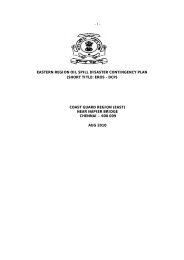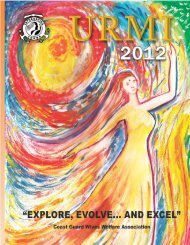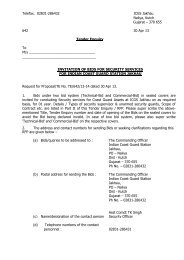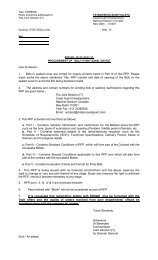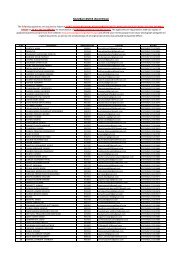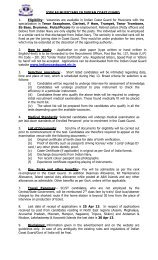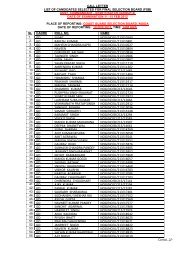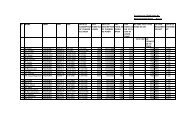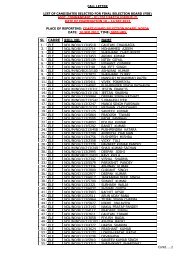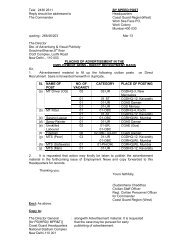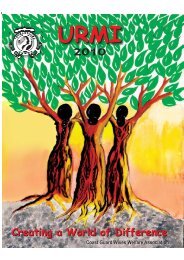MID CAREER PROFESSIONAL EXAMINATION - Indian Coast Guard
MID CAREER PROFESSIONAL EXAMINATION - Indian Coast Guard
MID CAREER PROFESSIONAL EXAMINATION - Indian Coast Guard
Create successful ePaper yourself
Turn your PDF publications into a flip-book with our unique Google optimized e-Paper software.
<strong>MID</strong> <strong>CAREER</strong> <strong>PROFESSIONAL</strong> <strong>EXAMINATION</strong><br />
1. In order to refresh and update professional knowledge of mid-seniority officers, a<br />
Mid Career Professional Examination (MCPE) for officers has been introduced in the<br />
<strong>Coast</strong> <strong>Guard</strong> w.e.f. 2000.<br />
Aim<br />
2. The aim of the examination is to promote self-study of professional subjects. This<br />
will also improve and update the professional knowledge and quality of middle seniority<br />
officers in the <strong>Coast</strong> <strong>Guard</strong>.<br />
Frequency of Examination<br />
3. The examination will be held in the month of August / September every year unless<br />
promulgated otherwise.<br />
Mode of conduct<br />
4. One written paper comprising of multiple answer type and short answer type<br />
questions followed by Oral Board.<br />
Eligibility<br />
5. All officers of 10 to 13 years of service as on 01 Jan of the year of the examination<br />
would be eligible to appear.
2<br />
Requirement to Qualify<br />
6. Qualifying the MCPE will become pre-requisite for consideration of officers for the<br />
following:-<br />
(a)<br />
(b)<br />
(c)<br />
Staff course and LDMC<br />
Command of FPV and above<br />
Appointments in Key Command and Staff Commanders and CSOs etc.<br />
7. In addition to qualifying in the MCPE, the record of officers as reflected in their<br />
confidential reports would be taken into account while selecting officers for Staff course,<br />
LDMC, Command and Key Staff appointments.<br />
Subjects and Syllabi for examination<br />
8. The subjects / detailed syllabi for the examination for GD, Tech and Law officers<br />
have been placed as Appendix ‘A’ , ‘B’ and ‘C’ respectively.<br />
Standard of Knowledge<br />
9. The standard of knowledge from officers on various topics is indicated as ‘A’, ‘B’,<br />
or ‘C’ in respective syllabi, which stand for -<br />
‘A’ - Thorough Knowledge<br />
‘B’ - Working Knowledge<br />
‘C’ - Knowledge of principles only<br />
Pass Percentage<br />
10. The MCPE consists of written examination and oral board for 150 and 100 marks<br />
respectively. Percentage of marks to qualify in the examination will be as follows:-<br />
(a) Written Papers - 55 %<br />
(b) Oral Board - 60 % ( Only for General Duty Officers)<br />
11. The breakdown of marks for written paper is mentioned in the syllabi and the<br />
breakdown of marks for oral board is placed at Appendix ‘D’.<br />
12. An officer obtaining an overall average of 75 % and above will be awarded a first<br />
class.
3<br />
Attempts permitted<br />
13. An officer will be permitted maximum of three attempts to qualify in the<br />
examination. It is mandatory that officers appear in written examination and oral<br />
examination ( if passed in written examination) in the first attempt, failing which they will<br />
be disqualified, in the entire examination. The absence of a candidate after volunteering<br />
for the examination without valid reasons would constitute a failure at one attempt.<br />
However, if a candidate desires to withdraw his name from the examination without such<br />
penalty, due to valid reasons, he should forward his request to CGHQ through his<br />
Administrative Authority.<br />
14. An officer will only be awarded a first class grading if he passes in the first attempt,<br />
notwithstanding marks obtained in the subsequent attempts.<br />
Conduct of Examination<br />
15. (a) The overall conduct of the MCPE will be overseen by a board at CGHQ,<br />
which will comprise of<br />
DDG - President<br />
D(Pers) - Permanent Member<br />
D(HRD) - Permanent Member<br />
D(Mat), D(FM) and CLO -<br />
Optional members<br />
(for Engg / Elect and Law officers)<br />
(b) The setting of question papers and evaluation of answer books will be done<br />
by Officers specially nominated by the board.<br />
(c) Written examinations will be conducted simultaneously at Mumbai , Chennai<br />
and Port Blair under RHQ arrangements on the dates promulgated by CGHQ.<br />
(d) Commanding Officers of ships / establishments are to forward names of<br />
eligible officers desirous of appearing in MCPE along with the prescribed proforma<br />
(placed at Appendix ‘E’), duly completed, to their respective administrative<br />
authorities by 10 May every year. The administrative authorities are to forward<br />
consolidated lists with the proforma to CGHQ by 31 May of that year.<br />
(e) CGHQ after scrutiny, will promulgate the list of candidates appearing for the<br />
examination indicating index number allotted to them.<br />
(f) Supervisory board for each center comprising of two commandants for every<br />
15 candidates is to be appointed by the authority conducting the examination at a<br />
particular center.
4<br />
Oral Board<br />
(g) The required number of question papers will be forwarded in a sealed cover<br />
by CGHQ to the administrative authority that will hand them over to the President,<br />
Supervisory Board on the day of the examination. The President, Supervisory<br />
Board in the presence of the candidates will open the question papers.<br />
(h) Before the commencement of the examination, the President, Supervisory<br />
Board will obtain the signatures of the candidates against their index number on<br />
nominal roll. Candidates are to indicate only their index number on all answer<br />
books / additional sheets in the space provided for it. They are not to write their<br />
names on the answer books / additional sheets.<br />
(j) All candidates will be identified and seated according to a seating plan,<br />
which will be drawn in advance by the President, Supervisory Board. A copy of the<br />
seating plan indicating the names of invigilating officers, the periods for which they<br />
invigilated, the venue of examination and nominal roll of candidates, are to be<br />
enclosed with the worked answer books by the President, Supervisory Board. The<br />
worked answer books are to be arranged in an ascending order of the index number<br />
and sealed in an envelope along with the enclosures mentioned above.<br />
(k) At the conclusion of the examination, same day, the envelope containing the<br />
worked answer books together with extra question papers and the other enclosures is<br />
to be despatched in a sealed packet marked ‘Personal and Confidential’ to the Dte of<br />
HRD, CGHQ, New Delhi.<br />
16. Oral Examinations will only be conducted for GD/PN Officers at Chennai / Mumbai<br />
or both places simultaneously depending upon the number of candidates by a board<br />
constituted by CGHQ as under :-<br />
(a) DIG(GD) - President (with AOPV / OPV command experience)<br />
(b) Two commandants - Members (with OPV/FPV command experience )<br />
(GD)<br />
17. The candidates who fail to qualify in ROR are to be re-examined after 2 weeks. In<br />
case the candidates fail in the oral board then the candidate, if eligible has to appear again<br />
for written examination next year. The candidates passed in re-examination will be given<br />
pass percentage in the oral board.<br />
Requests for change of Examination centre<br />
18. Officers who are unable to take the examinations at the centre notified due to leave /<br />
temporary duty / permanent transfer are to apply to their respective administrative<br />
authorities requesting for a change of centre. Administrative authorities may permit<br />
change of centre as required, keeping CGHQ informed. Extra question papers and answer<br />
books to the extent of 25 % of the registered strength of the candidates will be provided<br />
to each centre to cater this. However, in case such requests for change of centre exceed
5<br />
25 % of the strength, administrative authorities may forward demand for additional<br />
question papers / answer books to CGHQ at least three weeks prior to the commencement<br />
of the examination, if the centre cannot accommodate additional candidates due to lack of<br />
question papers / answer books.<br />
Evaluation and Declaration of Results<br />
19. (a) On receipt of worked answer books, CGHQ will arrange to get papers<br />
evaluated by duly appointed examiners. The results of the written examination will<br />
be promulgated after the board approves these.<br />
(b) The officers who qualify in the written examination are to appear for the oral<br />
board constituted by the CGHQ. The result of the oral examination will be<br />
forwarded to the CGHQ. The final results will be promulgated after the approval of<br />
the MCPE board.<br />
Review of Results<br />
20. There is no provision either for review of results / revaluation of answer books or<br />
for the perusal of evaluated answer books. However, requests for re-totaling of marks<br />
scored by a candidate may be forwarded to CGHQ by administrative authorities. As this<br />
may generate in fructuous work / avoidable correspondence, administrative authorities may<br />
exercise careful scrutiny of such request before recommending them.<br />
Grant of Waivers / Relaxation of Eligibility conditions<br />
21. Officers should endavour to appear for examination as soon as they enter into<br />
eligibility zone. No waivers or relaxation of eligibility conditions will be granted except in<br />
rare cases of service exigencies or in case hospitalisation / sick leave, with a specific<br />
recommendation from the Region Commander.
6<br />
Appendix ‘A’<br />
(Refers to Para 8 )<br />
REVISED SYLLABI<br />
MCPE<br />
GENERAL DUTY OFFICERS
7<br />
1. GENERAL NAVIGATION<br />
Marks – 25<br />
S.NO. SUBJECT SOK<br />
1 Type of charts, Information shown on charts Standard Symbols and<br />
Abbreviations used, Distinguishing well-surveyed chart, Correction<br />
of charts. Datum shift, ECDIS and electronic charts<br />
A<br />
2 Various Navigational publications B<br />
3 Methods of obtaining position line, Methods for Fixing ship A<br />
4 Pilotage, Navigation in <strong>Coast</strong>al waters, Navigation in canals and in<br />
coral waters. Passage planning, Passage in fog and thick weather<br />
5 Anchoring – Planning and Execution A<br />
6 IALA Maritime Buoyage system in Region A A<br />
7 Aids to Navigation – EM log, Echo sounder, Radar, GPS,<br />
Differential GPS, Gyro, magnetic compass---Principles And<br />
limitations<br />
8 Blind Pilotage with specific reference to bridge organization A<br />
9 Navigational Instruments - Sextant, Anemometer, Distance meter,<br />
Batternberg<br />
A<br />
B<br />
B<br />
10 Relative velocity triangle, Problems on opening/closing on a steady<br />
bearing and changing station.<br />
11 Tides, Tidal Streams and currents. Tide calculation for standard<br />
ports<br />
A<br />
B<br />
12 Tropical Revolving Storms A<br />
13 NDB, Chart correction log, Navarea log, Ships log book A<br />
14 Bridge organization and Procedures A<br />
15 Pilotage claims B
8<br />
2. CG TACTICS & SCOUTING OPERATIONS<br />
Marks – 10<br />
S.NO. SUBJECT SOK<br />
1 Terminology & Definition. Scouting, Search and Patrol, Method of<br />
Search And Patrol, Tracking and Reconnaissance, Terms used in<br />
Scouting: Track spacing, Sweep width, Coverage factor<br />
2 Factors affecting and Planning of Scouting Mission. Aim,<br />
Initiation of Scouting operations, Consideration in search design,<br />
Security of search, Economy in use of scouts, Accuracy of<br />
Navigation, Effectiveness of search<br />
B<br />
B<br />
3 Area of Search. Entry probable area, Calculation of drift factor. B<br />
4 Search and Patrol Types of Search: Rectangular search, Expanding<br />
square search, Intercepting search. Types of patrol: Fixed station<br />
patrol, Linear patrol, Cross over patrol.<br />
B<br />
5 Principles of Boarding operations, Conduct of antismuggling/poaching<br />
operations. Gradual use of force.<br />
A
9<br />
3. POLLUTION RESPONSE AND CONTROL<br />
Marks – 10<br />
S.NO. SUBJECT SOK<br />
1 Marine environment – Pollution response and pollutioncontrol;P3C<br />
concept for marine environment; Pollution response action; <strong>Coast</strong><br />
<strong>Guard</strong> role; Contingency planning Tier approach for oil spill<br />
response.<br />
2 Oil spill at sea – Causes of spill; Behavior of oil; Properties of oil’<br />
Air surveillance’ Calculation of quantity, direction and speed of<br />
slick’ Weathering of oil; Oil spill containment; Type of booms;<br />
Booms failure; Booms anchoring; Deployment of boom.<br />
3 Recovery and disposal – Various types of skimmers; Principle of<br />
skimmer and their operation; Storage devices; Transportation of oil;<br />
Disposal of recovered oil and oily waste<br />
4 Alternative method of disposal of oil spill – In-situ burning<br />
Bioremediation; Principle of bioremediation; Pro and cons of<br />
Bioremediation and in-situ burning.<br />
5 Oil spill on shore line – Migration of oil on shore line. Types of<br />
shore line; Effect of oil on shore line.; Methods of shore line clean<br />
up; Coordination of agencies involved in shore line clean up.<br />
6 OSD/Chemical agents – Collecting agencts; Sinking agents;<br />
Dispersant; Types of dispersant’ Basic principle of OSD; Basic<br />
Guidelines for use of OSD; Window of opportunity for use of OSD.<br />
7 Legislation – NOS-DCP; National & International legislation<br />
including merchant shipping Act 1958; Environment protection Act;<br />
<strong>Indian</strong> port Act; Fund convention; MARPOL 73/78 annex-I; IOPC<br />
fund; Filing of claims.<br />
8 CG Pollution equipments – Pollution Response equipments with<br />
<strong>Coast</strong> <strong>Guard</strong>; Usage and operation.<br />
9 Handling of CG vessels for combination oil pollution –<br />
Capabilities and limitation.<br />
(a) AOPV’S/OPV’S<br />
(b) FPV’S/IPV’S<br />
A<br />
A<br />
A<br />
B<br />
B<br />
B<br />
B<br />
B<br />
B<br />
10 Case study of major oil spill disasters B
10<br />
4. SAR OPERATIONS<br />
Marks – 15<br />
S.NO. SUBJECT SOK<br />
1 Search & Rescue – Objectives and benefits of SAR; Component of<br />
SAR.<br />
2 SAR Organisation – Various international conventions; Role of<br />
<strong>Coast</strong> <strong>Guard</strong> for SAR; National SAR organization; National SAR<br />
plan; National SAR Communication system.<br />
3 SAR Operation – Various maritime and aeronautical Distress; False<br />
alerts and their prevention; Sea-Air coordinated search Techniques;<br />
Planning and operations; Rescue planning and Operations; Rescue<br />
planning and operations; Mission orders.<br />
A<br />
A<br />
A
11<br />
5. MARITIME LAW<br />
Marks – 10<br />
S.NO. SUBJECT SOK<br />
1 International Maritime Organisation (IMO) – Organisation and its<br />
Role.<br />
2 UNCLOS III, High Seas – its meaning, Freedom of the High Seas<br />
meaning, Fishing on the High Seas. Piracy – its object and where it<br />
can be committed, Right of hot pursuit.<br />
3 Fisheries Regulations and Fishing rights, Fishing gear Materials –<br />
classification of fishing gears, trawl net-classification of trawl gear,<br />
Bull trawl.<br />
B<br />
B<br />
B<br />
4 Protected marine species B<br />
5 Offshore oil rigs and management of oil exploration B<br />
6 SBMs and oil/gas submarine pipeline B<br />
7 International Humanitarian Law and the Geneva Conventions of<br />
1949, the First Geneva Convention (for wounded and sick), the<br />
Second Geneva Convention (Maritime Convention), the Third<br />
Geneva Convention (Treatment of POWs), the Fourth Geneva<br />
Convention (Civilians), and the Geneva Convention Act, 1960<br />
(CGO 12/89).<br />
B<br />
8 The Merchant Shipping Act, 1958 – General Administration (Part<br />
III), Certificates of Officers (Part VI), Collisions, Accidents at sea<br />
and liability (Part X and XA), Prevention and containment of<br />
pollution of the sea by oil (Part XIA), Wreck and Salvage (Part XIII)<br />
9 The Maritime Zones of India (Regulations of Fishing by Foreign<br />
Vessels) Act, 1981 and Rules framed there under (MZI Rules, 1982)<br />
10 The Territorial Waters, Continental Shelf, Exclusive Economic Zone<br />
and Other Maritime Zones Act, 1976.<br />
11 <strong>Coast</strong> <strong>Guard</strong> Law – Procedures relating to Summary Trial, Board of<br />
Inquiry, Recording of Evidence, and Abstract of Evidence, hearing<br />
of charge and disposal<br />
B<br />
B<br />
B<br />
A
12<br />
6. CG ADMINISTRATION<br />
Marks – 05<br />
S. NO. SUBJECT SOK<br />
1 CGHQ Organisation with duties and function of various<br />
Directorates<br />
B<br />
2 Accounting of Public and Non-Public funds. A<br />
3 Custody, accounting of cash/stores. A<br />
4 Important policies in force B<br />
5 Duties of various departments on boards ships A<br />
6 Basic knowledge of refit, types of refit, security organisation B<br />
7 Pay & Allowance of CG Personnel, Promotion rules, condition of<br />
service, Travel entitlement (Ty/PMT duties).<br />
8 CB’s, BR’s, SP’s, CD’s – care, custody and accounting, muster,<br />
destruction, loss of CB’s and safe keys<br />
A<br />
A<br />
9 Handing/taking over command A<br />
10 Conventions of service writing, security classification, appendixes,<br />
enclosures, headings, spacing, abbreviations, code words,<br />
nickname’s etc.<br />
11 Service correspondence, layout, general rules, types of<br />
correspondence-service letter, DO, letters to civilians, Govt of<br />
India letter, service note.<br />
C<br />
C<br />
12 Delegated financial powers rules (DFPR) C<br />
13 Accommodation orders/Authorised Married Establishment scales<br />
for officers/EPs and civilian personnel.<br />
C<br />
14 Housing/Motor Car/Scooter/Computer Advance B<br />
15 Key organisation. B
13<br />
7. CURRENT AFFAIRS<br />
Marks - 05<br />
S. NO. SUBJECT SOK<br />
1 Areas of world dispute with particular reference to South<br />
Asia/West Asia and the <strong>Indian</strong> Ocean region.<br />
2 International and regional organizations UNO, UNESCO, FAO,<br />
ICAO, WHO, Arab League, the Warsaw Pact, NATO etc.<br />
3 East West relations : The rise and decay of regional pacts and<br />
military alliances: role of neutral and uncommitted nations. The<br />
third World, North-South/South-South dialogue. The Unipolar<br />
World relevance and NAM.<br />
4 National and International terrorism including low intensity<br />
conflicts.<br />
5 India’s neighbours Pakistan, Nepal, Bhutan, Bangladesh,<br />
Myanmar, Sri Lanka, Maldives.<br />
6 Countries of South East Asia, ASEAN, recent political/military<br />
changes & re-percussions on India.<br />
7 <strong>Indian</strong> Affairs. The Five Year Plans and resources to implement<br />
them. Development projects and their achievements. <strong>Indian</strong><br />
Constitution and the roles of Central and State governments.<br />
B<br />
C<br />
B<br />
C<br />
B<br />
B<br />
B<br />
8 Defence budget, Defence PSUs, DRDO labs & their organization B
14<br />
8. LOGISTICS<br />
Marks - 05<br />
S.NO. SUBJECT SOK<br />
1 Stores – permanent/consumable, demand/supply/survey and loss<br />
statement.<br />
C<br />
2 Ship allowance list. C<br />
3 Local Purchase Procedures and Accounting. B<br />
4 Classification & categories of uniforms. C<br />
5 Movement Control Organisation, Warrants and MC notes C<br />
6 Preparation of Statement of Case B<br />
9. SHIP HANDLING AND ROR<br />
Marks – 10<br />
S.NO. SUBJECT SOK<br />
1. Ships Handling. Propulsion and Steering of ships, Handling ships<br />
in narrow waters, Handling ships in heavy weather.<br />
2. Ship Borne Helo Operations . Basic capabilities of CG Aircraft<br />
(Dornier, Helicopter, ALH) Restrictions imposed on aircraft<br />
operations due to weather and role configuration.<br />
A<br />
A<br />
3. Handling power boats A<br />
4. Ship handling during , SKBDL, Towing operations and Pollution<br />
response operations<br />
B<br />
5. ROR: International Regulations For Preventing Collisions At<br />
Sea, 1972<br />
Part A<br />
Part B to Part D<br />
Part E<br />
B<br />
A<br />
B
15<br />
10. COMMUNICATION AND GUNNERY<br />
(Total Marks – 15)<br />
SECTION-I : COMMUNICATION<br />
Marks - 10<br />
S. NO. SUBJECT SOK<br />
1. Area broadcast, ships shore and fixed services/land lines, passage<br />
communication – SOP/TOP, Sailing order, Arrival/departure<br />
signal, CHOP timing and Shift of broadcast. Security classification<br />
and procedures, Handling of exclusive message, INMARSAT,<br />
Abbreviations used, Records maintained by Communication<br />
department, Internet, Intranet, E-mail, SAR communication,<br />
GMDSS, Air-sea communication.<br />
A<br />
SECTION-II : GUNNERY<br />
Marks - 05<br />
S.NO. SUBJECT SOK<br />
1 Knowledge of 76/62 SRGM, 2A42 30 mm Medak and 40/60<br />
mounting with particular reference to rate of fire and effective<br />
ranges, firing precautions and mis-fire procedure.<br />
A<br />
2 Knowledge of spraying, sprinkling and flooding arrangement A<br />
3 Capabilities and limitations of small arms, Safety rules of Small<br />
Arms<br />
4 Accounting, custody, precautions regarding arms, ammunition and<br />
explosives. Issue of magazine keys & small arms<br />
5 Landing and Boarding party organizations with special emphasis<br />
on<br />
(i) Boarding Officer’s duties<br />
(ii) Documents to be carried<br />
(iii) Documents to be verified from vessel being boarded<br />
A<br />
B<br />
B<br />
6 Responsibilities of Gunnery officer B<br />
7 List of books and records maintained by Gunnery deptt B<br />
8 Watch and station Bill, Watch and Quarter Bill, Action messing,<br />
Emergency action stations and securing stations<br />
A<br />
9 <strong>Coast</strong> <strong>Guard</strong> (ceremonial) rules 1988 A
16<br />
11. ENGINEERING, NBCD, FIRE FIGHTING AND<br />
DAMAGE CONTROL<br />
Section - I : Engineering<br />
Marks - 10<br />
(a) Propulsion System of Ship<br />
S.NO. SUBJECT SOK<br />
1 Type of main propulsion systems, advantages and disadvantages,<br />
methods of obtaining astern power.<br />
B<br />
2 Power transmission arrangement in the ships –working principles. B<br />
3 Main propulsion system control position arrangement and working<br />
principles.<br />
4 Factors affecting fuel economy, specific fuel consumption,<br />
power speed relationship, types of fuels, transmission losses.<br />
5 Precautions for operation of main engines, preparatory procedures<br />
and dangers of mal-operation in ships in which serving / served.<br />
6 Emergency procedures to be followed for safe operation of<br />
machinery in the event of loss of electric power, loss of<br />
lubrication, failure of important auxiliaries, in ships in<br />
which served / serving.<br />
B<br />
B<br />
B<br />
B<br />
(b) Auxiliary Machinery<br />
S.NO. SUBJECT SOK<br />
1 Functions of important auxiliary and domestic machinery fitted in<br />
ships, effects of failure – care in operation.<br />
B<br />
2 Standby capacities of generating plants. B<br />
3 General knowledge regarding causes of machinery noise/vibration<br />
and their effects<br />
C
17<br />
(c) Maintenance, Repairs, Refits and Returns<br />
S.NO. SUBJECT SOK<br />
1 On board maintenance philosophy, system of maintenance, repairs<br />
and refits of ships.<br />
B<br />
2 Factors affecting operational cycle of ships, refit intervals. B<br />
3 Factors affecting operational cycle of ships, refit intervals. B<br />
4 Role and responsibilities of CGRPS, RHQ’S. B<br />
5 Planned preventive maintenance system, implementation of<br />
follow-up.<br />
B<br />
(d) Diesel Engines. Precautions for safe exploitation of diesel engines need to<br />
avoid low – load operation.<br />
(Contd… .Section II)
18<br />
Section-II : NBCD, Fire Fighting & Damage Control<br />
S.NO. SUBJECT SOK<br />
1 Duty watches and security rounds, responsibilities of OOD Duty<br />
SO’S and DC Patrol.<br />
2 Damage Control and Fire Fighting organisation at sea and in<br />
harbour. Welding organization on board ships.<br />
A<br />
A<br />
3. Parts of ship and departmental organisation B<br />
4 NBCD – States of readiness B<br />
5 NBCD Organisation and returns<br />
6 Precautions to be taken during underwater activities (diving and<br />
operation of machinery)<br />
B<br />
7. Principles of fire-fighting and major / minor fire-fighting<br />
equipment.<br />
A
19<br />
12. ELECTRICAL<br />
S.NO SUBJECT SOK<br />
Marks - 05<br />
1 Service requirements of generators, various distribution systems<br />
and arrangements on ships.<br />
2 Converted supplies and emergency supplies and their<br />
applications/service where used. The voltage and frequency<br />
standards for converted supplies.<br />
C<br />
C<br />
3 Precautions/procedures for connecting shore supply C<br />
4 Arrangement/actions to maintain power supply under damage<br />
conditions in ships.<br />
C<br />
5 Electric shock and care of power equipment C<br />
6 Precautions to be taken during dry docking with specific reference<br />
to earthing and bonding of ships.<br />
C<br />
7 Principle of GPS and DGPS C<br />
8 Philosophy of maintenance followed onboard ships C<br />
9 ICCP for steel and aluminum hulls, principle and precautions C<br />
10 Basic radar equation and factors affecting<br />
range and accuracy.<br />
C<br />
11 ARPA displays C<br />
12 Principle and operation UHF/DF and IFF C<br />
13 Principle and operation of SATCOM C<br />
14 EMI Hygiene onboard ships C<br />
15 Layout of typical weapon system onboard a ship. C<br />
16 Electro optical fire control system(EOFCS) of SRGM C<br />
17 Thermal Imagers C
20<br />
13. INFORMATION TECHNOLOGY<br />
Marks – 05<br />
I<br />
Introduction<br />
Familiarise with basic concepts of computer<br />
Basic I/O Systems<br />
IT Tools & Application<br />
A<br />
A<br />
B<br />
II<br />
Operating System<br />
Introduction of Operating System<br />
Personal Computer Software<br />
B<br />
B<br />
III Internet C<br />
Introduction to Internet Tools and Application<br />
IT Security<br />
E-mail<br />
IV LAN and Networking B<br />
LAN and its components<br />
WAN and its components<br />
V Introduction to Hardware B<br />
Storage Devices<br />
Printers<br />
Modems<br />
Scanners<br />
RAM, ROM, EPROM & PROM
21<br />
14. SEAMANSHIP<br />
PART – I<br />
Marks - 10<br />
S.NO SUBJECT SOK<br />
1 Type of Ships: Warships, Merchant Ships and Sailing Vessels B<br />
2 Handling wire ropes B<br />
3 Handling hawsers: Berthing hawsers. Fitting, supply and<br />
maintenance of hawsers.<br />
A<br />
PART – II<br />
S.NO SUBJECT SOK<br />
1 Anchor and Cables: Type of anchors and chain cable. Associated<br />
gear, Associated fittings. Maintenance, survey and testing of<br />
anchors & cables.<br />
A<br />
2 Anchor Work – Anchoring and weighing A<br />
3 Towing and taking in Tow: Towing gears. Preparation for towing.<br />
Taking in tow, slipping and recovering tow. Precautions when<br />
towing or being towed.<br />
4 Underway Replenishment at Sea: Methods. General requirements.<br />
Fuelling by the astern method.<br />
A<br />
A<br />
5 Maintenance of safety and survival equipment. A<br />
6 Seamanship organisation and upkeep: Seamanship organization in<br />
warships, seamanship equipment upkeep.<br />
A<br />
PART-III<br />
S.NO SUBJECT SOK<br />
1 Types of maintenance followed on board B<br />
2 Different types of log books B<br />
3 Refit Organisation, CGRPS Organisation, maintenance staff of<br />
RHQs, procedure for off-loading jobs in <strong>Coast</strong> <strong>Guard</strong>, conducting<br />
of refit.<br />
4 Ship Husbandry, Planned preventive maintenance – Kalamazoo –<br />
cards – documentation.<br />
B<br />
B
22<br />
15. LEADERSHIP<br />
Marks – 05<br />
S.NO SUBJECT SOK<br />
1 Concept of leadership, management and command – Definition<br />
of Leadership; Military Leadership; Relationship and<br />
Management; Approach to Leadership etc.<br />
2 Traits – Leadership Traits; Are Leaders born; in-born traits;<br />
Examples; Traits positively to be found in leaders; Traits of<br />
Military Leaders; Ethics and morals in the military etc.<br />
B<br />
B<br />
3 Style – Authoritarian; Democratic Leadership; Grid approach etc B<br />
4 Indicator of Leadership – Symbolic behaviour; Decision making<br />
behaviour; Concern for Task etc.,<br />
5 Characteristics of Leader – Mental ability; Courage; Maturity<br />
Social orientation; Perception; Motivation etc.,<br />
6 Group Dynamics – Function of groups; Understanding of goals;<br />
Sense of responsibility’ Needs for autonomy; Interest and<br />
Motivation etc.<br />
B<br />
B<br />
B<br />
7 Inter personnel Relations – Transactional Analysis. B<br />
8. Biographies of following leaders: - C<br />
(a) Mac Arthur<br />
(b) Rommel<br />
(c) Mountbatten<br />
(d) Field Marshal Manekshaw
23<br />
16. MARITIME STRATEGY AND MILITARY/ NAVAL<br />
BATTLES/CAMPAIGNS<br />
S.NO SUBJECT SOK<br />
Marks – 05<br />
1 <strong>Indian</strong> Maritime strategy – Features of <strong>Indian</strong> Ocean and its<br />
strategic importance; Concept of maritime strategy in 21 century;<br />
<strong>Coast</strong> <strong>Guard</strong> multi-mission approach to maritime strategy.<br />
B<br />
2 CG and Maritime strategy – Role of <strong>Coast</strong> <strong>Guard</strong> in B<br />
constabulary function in EEZ; EEZ surveillance; Security of<br />
offshore installation; Ports; <strong>Coast</strong>al approaches and other areas;<br />
<strong>Coast</strong> <strong>Guard</strong> as lead agency for maritime security; Sharing of<br />
responsibility with other partners viz. Navy, Port, Customs, Police,<br />
DG Shipping, Private sector and Public Sectors and District<br />
administration; Detection, Prevention, Protection and Deterrence<br />
as well as Consequence Management for drug and arms<br />
smuggling, Piracy, Terrorist activities and Environmental<br />
degradation<br />
4 Indo-Pak conflicts – 1948, 65 and 71. B<br />
5 The Falklands War 1982 B<br />
6 US campaign on Iraq B<br />
7 Kargil and its aftermath B
24<br />
Appendix ‘B’<br />
(Refers to Para 8 )<br />
REVISED SYLLABI<br />
MCPE<br />
TECHNICAL OFFICERS<br />
1. The syllabus consists of 5 parts as under as mention below :-<br />
Part I – Administration<br />
Part II – Technical Management Common for all Technical Officers<br />
Part III – Information Technology<br />
Part IV –<br />
Part V –<br />
For Marine Engineer / Air Engineer<br />
For Electrical / Air Electrical<br />
2. The part I,II & III are common for all Technical officers ( Marine Engineering / Air<br />
Engineering/ Electrical / Air Electrical) . The Part IV related to both Marine Engineer / Air<br />
Engineer Officers . The part V is for both Electrical / Air Electrical Officers.
25<br />
(1) Staff Duties<br />
PART-I : ADMINISTRATION<br />
(Max Marks – 20)<br />
(Common for all Technical Officers)<br />
S.NO. SUBJECT SOK<br />
Marks -10<br />
1 Forms of correspondence and service writing B<br />
2 Operational and Administrative organisation of the CG in general,<br />
material and repair organisation in particular<br />
3 Knowledge of organisation of the Army ,Navy and<br />
Air force<br />
4 Basic knowledge of research Development and inspection<br />
Organisation in ministry of Defence[DNRD,DWP, DPI(N),<br />
DRDO, DGQA etc.,<br />
B<br />
C<br />
C<br />
5 Basic knowledge of CG Act C<br />
(2) Ships Administration<br />
Marks -05<br />
S.NO. SUBJECT SOK<br />
1 A General knowledge of Regs. CG B<br />
2 Responsibility of Officers regarding public and Non Public Funds B<br />
3 Stores-permanent/temporary, demand/Supply Survey and Loss<br />
statements<br />
B<br />
4 Security –personnel and material security organisation Of ships C<br />
5 CBS-care, Custody and accounting musters, destruction, Loss of<br />
CBs/Keys<br />
B<br />
6 Duties of various departments on board ships B<br />
7 Sailors advancement rules, GCB award, Deprivation-Restoration,<br />
welfare agencies, leave rules, release routines, Travel entitlements,<br />
temporary/permanent duty<br />
8 Summary punishment-warrant and non-warrant punishment,<br />
duties and privileges of S.O./EP, Board of Inquiry/Investigation<br />
B<br />
B
26<br />
9 Action organisation-degree of readiness, watch and station bill,<br />
Action messing<br />
(3). General<br />
B<br />
Marks –05<br />
S.NO. SUBJECT SOK<br />
1 Basic knowledge of civil works procedure C<br />
2 Decoration and awards in the <strong>Coast</strong> <strong>Guard</strong> C<br />
3 Industrial factories Act 1949 C<br />
4 Geopolitics –Issues/Developments pertaining to <strong>Indian</strong> Ocean<br />
littoral and their impact on our security (Articles in the IDSA<br />
Journal and review would be useful reference)<br />
B<br />
(Contd… ..Part-II)
27<br />
PART – II : TECHNICAL MANAGEMENT<br />
(1) General Management<br />
(Common for all Technical Officers)<br />
(Max Marks – 40)<br />
S.NO. SUBJECT SOK<br />
Marks -10<br />
1 Management-Responsibility and functions, functions And role of<br />
good manager, Organisation-Necessity, Classification, type of<br />
organisation with reference to(CGHQ, RHQs and store depots)<br />
2 Awareness of <strong>Indian</strong> Social, Political & Economic Environment in<br />
the industrial scene<br />
B<br />
C<br />
3 Montreal protocol C<br />
4 MARPOL Act C<br />
5 Pollution, Environment control & Industrial effluent Disposal C<br />
6 ISO 9000, ISO 9001, ISO 9002, ISO 9001-2000 C<br />
(2) Material Management<br />
Marks -10<br />
S.NO. SUBJECT SOK<br />
1 Importance of material Management, Inventory, ABC Analysis,<br />
SAP Analysis, Material Handling, VED Analysis, Quality control,<br />
Duties of Maintenance, Management and Administration of store<br />
Depots .Preservation/Stowage of inventory.<br />
B
28<br />
(3) Management Techniques<br />
S.NO. SUBJECT SOK<br />
Marks -05<br />
1 Work study, Methods Improvement, Time study effect on working<br />
conditions and environments<br />
2 Operations Research Important managerial applications, Elements<br />
of OR technique, simplex method<br />
3 Operating systems, function of Information technology systems,<br />
Internet, Intranet, LAN, windows, NT, E-mail system, world wide<br />
web.<br />
B<br />
B<br />
B<br />
4 Value Analysis, Cost reduction and importance of value Analysis. C<br />
5 Network Analysis, Network as planning and control tool, Elements<br />
of critical path method and PERT<br />
B<br />
(4) Personnel Management<br />
S.NO. SUBJECT SOK<br />
Marks -05<br />
1 Functions of personnel management, Training motivation,<br />
leadership, Safety management, Management’s responsibility for<br />
safety Organisation , Disciplinary action against civilian employees<br />
C<br />
(5) Production and Planning Techniques<br />
S.NO. SUBJECT SOK<br />
Marks -05<br />
1 Need for production and planning control organisation, use of<br />
Computers and PERT for production and planning<br />
C
29<br />
(6) Refit Organisational structure<br />
Marks -05<br />
S.NO. SUBJECT SOK<br />
1 <strong>Indian</strong> PSUs-viz MDL, GSL, GRSE, CSL, HSL upto Asst Manager<br />
level procedure for requisition work/spares/stores, Requisition of<br />
contractors / subcontractors on approval list ,Monitoring of progress<br />
of repair work at all levels<br />
2 Financial Management, CSTs, PNCs Security/ Clearance of Bills,<br />
verification of costing viz. CIFU/FOB/TAXES/DUTIES, Liquidated<br />
charges etc. work of CDA/CGDA Organisation, Monitoring of<br />
Audit/Sanction of files, Bills, ledgers<br />
B<br />
B
30<br />
(1) Introduction<br />
PART-III : INFORMATION TECHNOLOGY<br />
(Common for all Technical Officers)<br />
S.NO. SUBJECT SOK<br />
Marks -10<br />
1 Familiarise with basic concepts of computer Basic I/O Systems<br />
Central Processing Unit Computer Organisation and System<br />
Software IT Tools & Application Understand utilizes of software<br />
packages like word processing, Power Point & .Access<br />
A<br />
(2) Operating System<br />
S.NO. SUBJECT SOK<br />
1 Introduction of Operating Sys tem Personal Computer Software A<br />
(3) Internet and Networking in <strong>Coast</strong> <strong>Guard</strong><br />
S.NO. SUBJECT SOK<br />
1 Introduction to Internet Tools and Application Communicating on<br />
the Internet, Internet Security, E-mail<br />
B<br />
(4) LAN and Networking in <strong>Coast</strong> <strong>Guard</strong><br />
S.NO. SUBJECT SOK<br />
1 LAN infrastructure in <strong>Coast</strong> <strong>Guard</strong> Various components of LAN and<br />
types Overviews of Computer networks<br />
B<br />
(5) Introduction to Hardware<br />
S.NO. SUBJECT SOK<br />
1 Storage Devices, Printers, Modems, Scanners RAM, ROM, EPROM<br />
& PROM<br />
C
31<br />
PART – IV : MARINE ENGINEERING/AIR ENGINEERING<br />
(For Marine Engineer / Air Engineer officers)<br />
(Max Marks – 80)<br />
Section – I : Damage Control and Fire Fighting<br />
S.NO. SUBJECT SOK<br />
Marks -25<br />
1 Damage control apparatus and fittings and their uses A<br />
2 Knowledge of ship’s stability, pumping and flooding in respect of<br />
ships in which served<br />
3 Knowledge of precautions to be observed immediately before,<br />
during after the docking and undocking<br />
4 Specific knowledge of method of fighting of various types of fires<br />
on board ships<br />
5 Emergency supply arrangements and principle of load setting during<br />
the damaged conditions<br />
A<br />
A<br />
A<br />
B<br />
6 Monitoring duties of technical personnel B<br />
7 Ventilation B<br />
(Contd… . Section II)
32<br />
Section - II : MARINE ENGINEERING<br />
1. Ship Construction and Machinery installation<br />
Marks –55<br />
S.NO. SUBJECT SOK<br />
1 Salient features of High speed Interceptor Boats, SDBs, IPVs/ FPVs,<br />
OPVs, AOPVs, PCVs, ACVs/Hovercraft; their principle<br />
Dimensions, capabilities and limitations etc<br />
2 Evolutions/activities in a new ship Construction, Machinery<br />
installation, commissioning and evolutions like D-448 & guarantee<br />
rectification. Responsibilities of classification societies etc<br />
3 Selection of engineering machinery/ Equipment/ system for new<br />
construction ship. Role of CG technical officers<br />
4 Salient features of shafts/GB/ME alignment, inclining experiment,<br />
HATS, Basin trial and SATS. Various types of stern tube<br />
arrangement in CG ships.<br />
C<br />
B<br />
B<br />
B<br />
5 Typical Machinery layout in various classes of CG ships C<br />
6 Dual class certification and damage stability. C<br />
2. Main Propulsion Machinery<br />
S.NO. SUBJECT SOK<br />
1 Modes of propulsion of CG ships A/C<br />
2 Construction, operation and maintenance of various main propulsion<br />
machinery/Diesel Engines, Gas Turbines including out board<br />
engines<br />
A/C<br />
3 Combined main propulsion plants requirements, installation features B<br />
4 New trends in main propulsion plants in <strong>Indian</strong> and International<br />
markets<br />
5 Tests & trials, preventive maintenance and procedures for different<br />
types of main propulsion<br />
C<br />
BC<br />
6 Ship building and allied industries in India C<br />
7 IS 3046 and its application in marine environment C
33<br />
3. Power Generation<br />
S.NO. SUBJECT SOK<br />
1 Salient feature of different types of power generation prime-movers<br />
for shipboard use<br />
2 Construction, operation and maintenance of various types of power<br />
generation plants on board different classes of ships, generators<br />
paralleling, loading/unloading<br />
C<br />
A/C<br />
4. Gearing, Shafting & Propellers<br />
S.NO. SUBJECT SOK<br />
1 Principles of construction, operation and maintenance of gearing<br />
systems on board ships<br />
2 Shafting and associated system for different class of ships;<br />
maintenance and operation<br />
3 Maintenance and operation of fixed-pitch, controllable pitch<br />
propellers and CPP systems on board different classes of CG ships<br />
4 Boats and ships with water jets, their installation, maintenance and<br />
operation<br />
A/C<br />
A/C<br />
A/C<br />
A/C<br />
5 Repair of propulsion shafts, re-sleeving and gauging A/C<br />
5. Auxiliary Machinery<br />
S.NO. SUBJECT SOK<br />
1 Construction, operation and maintenance principles of HP Air<br />
Compressors, LP Air compressors, Steering Gear, Distilling/RO<br />
Plants, motor driven pumps, condenser, heat exchangers, SW<br />
coolers, domestic and deck machinery , sewage treatment plants,<br />
Oily Bilge water separators, Garbage Disposal units on board CG<br />
ships<br />
A/C
34<br />
6. Ship’s Engineering Systems<br />
S.NO. SUBJECT SOK<br />
1 Construction (including materials of construction), Operation and<br />
maintenance features of ship board air, water (fresh, sea),<br />
lubricating oil, fuel, bilge and ballast, sewage systems on board<br />
CG ships<br />
A/C<br />
7. Refrigeration & Air Machinery<br />
S.NO. SUBJECT SOK<br />
1 Construction, operation and maintenance features of various types of<br />
shipboard refrigeration and air conditioning plants/systems<br />
A/C<br />
8. Machinery Controls<br />
S.NO. SUBJECT SOK<br />
1 Principles of operation and maintenance of pneumatic, hydraulic,<br />
electrical, electro hydraulic and electronic control systems and<br />
equipment on board ship Integrated Platform Management<br />
System(IPMS) and other systems Viz. Integrated Machinery Control<br />
System (IMCS/BDCS) their benefit and essential requirement.<br />
A/C<br />
9. Engineering Materials & Metallurgy<br />
S.NO. SUBJECT SOK<br />
1 Salient features of use of different materials of construction of<br />
engineering equipment/machinery /systems/including valves,<br />
pipeline, glands etc. in different environmental conditions such as<br />
high / low temperatures, corrosive liquids, fatigue, humidity etc.<br />
Engineering and science of composite materials<br />
A/C
35<br />
10. Oil, Fuel and Lubricants<br />
S.NO. SUBJECT SOK<br />
1 Range of oil, fuel & lubricants in CG service C<br />
2 Characteristic features/ properties of lubricating oil and fuel B<br />
3 Avcat system & testing B<br />
4 Maintenance of POL hygiene B<br />
5 Accounting of POL B<br />
11. NDT<br />
S.NO. SUBJECT SOK<br />
1 Principles of measurement, analysis and application of noise,<br />
vibration, shocks, for condition/health monitoring of marine<br />
machinery<br />
C<br />
2 Principles of NDT techniques in marine Engineering/inspection C<br />
12. Machinery Operation, Tests & Trials<br />
S.NO. SUBJECT SOK<br />
1 Salient features of engineering machinery/ equipment, systems<br />
Operation, routine and special tests, trials etc.<br />
B/C<br />
13. Engineering Documentation/Returns<br />
S.NO. SUBJECT SOK<br />
1 PPM systems, logs, documents and returns connected with<br />
Engineering/Electrical Department<br />
B
36<br />
14. Machinery Spares/Stores<br />
S.NO. SUBJECT SOK<br />
1 Engineering /Electrical machinery ranging and scaling B<br />
2 Introduction of new machinery/ equipment in service B<br />
3 Procurement/replenishment/ supply of machinery equipment,<br />
Spares, stores including fuels and lubricating oils<br />
4 Standardisation of engineering equipment and its impact on<br />
Inventory management<br />
C<br />
C<br />
5 Procurement of spares/stores through ARD C<br />
15. Preventive Cum Predictive Maintenance Policy for CG Ships<br />
S.NO. SUBJECT SOK<br />
1 Maintenance philosophy for CG ships and equipment/Machinery B<br />
2 Responsibility of ships, BMU, CGRPS, store depots with regard to<br />
maintenance of ships<br />
3 Refit/Refurbishment/Repair of engineering machinery/ equipment in<br />
BMUs/Dyds/Trade<br />
B<br />
B<br />
16. Engineering Machinery of New Acquisition/<br />
Construction ships<br />
S.NO. SUBJECT SOK<br />
1 Salient features of engineering machinery / Equipment pertaining to<br />
New acquisition / construction ships<br />
C
37<br />
17. Miscellaneous<br />
S.NO. SUBJECT SOK<br />
1 Ships upkeep-Hull preservation, Cathodic protection, ICCP and<br />
under water paint scheme<br />
B<br />
2 Corrosion prevention, Hull maintenance A<br />
3 Engineer Officers/Sailors training B<br />
4 Preservation of machinery/ equipment B<br />
5 Shelf life C<br />
6 Evaluation of machinery system under trial C
38<br />
PART – V : ELECTRICAL / AIR ELECTRICAL<br />
(For Electrical / Air Electrical Officers)<br />
(Max Marks – 80)<br />
SECTION - I : Power/Gyro/Nav-Aids<br />
S.NO. SUBJECT SOK<br />
Marks –45<br />
1 Service requirements of generators, various distribution systems and<br />
arrangements on ships.<br />
2 Converted supplies and emergency supplies, and their applications/<br />
service where used. The voltage and frequency standards for<br />
converted supplies.<br />
3 Care, maintenance and handling of secondary batteries on board<br />
ships and their applications. Difference between Tubular,<br />
Maintenance Free and Sealed Maintenance Free Batteries.<br />
A<br />
A<br />
A<br />
4 Precautions/Procedures for connecting shore supply. A<br />
5 Importance/necessity of stabilized shore supply for ships.<br />
Specifications/fluctuations allowed in stabilized supplies.<br />
6 Actions/Arrangements to maintain power supply under damage<br />
conditions in ships.<br />
7 Three phase supply, its sequence of connections; and Star and delta<br />
connections<br />
8 Methods of Paralleling/Synchronization of generators and load<br />
sharing<br />
9 Load trials of alternators and details of acceptance carried out on the<br />
main alternators on installation on board new construction ships<br />
10 Need for voltage regulators and principle of operation of various<br />
types of voltage regulation<br />
A<br />
A<br />
A<br />
A<br />
B<br />
B<br />
11 Basic maintenance and care of power equipment B<br />
12 Electric shock and care of personnel. B<br />
13 Function of automatic voltage regulators on board ships.<br />
Description and working principles of AVRs.<br />
14 Remote control and monitoring of power and general machinery in<br />
ships. Concept of power automation, Low Fire Hazard (LFH) cables<br />
and soft starters.<br />
15 Precautions to be taken during dry docking with specific reference<br />
to earthing and bonding of ships.<br />
A<br />
B<br />
A
39<br />
S.NO. SUBJECT SOK<br />
16 Design criteria for ships power systems, diversity factor, utility<br />
factor, Load calculations, stability measurement methods.<br />
17 Modern trends in frequency and speed control of motors and<br />
generators<br />
18 Principle of EM Log. Different types of EM Logs in Service.<br />
Calibration procedure for EM Logs.<br />
19 Free Running Gyro, conversion of a Free Running Gyro to a North<br />
Seeking Gyro Compass, Gyro failure alarms, Static Frequency<br />
Converters, Gyro supplies and various types of Gyros used in<br />
service.<br />
20 Method of acceptance of gyro from a repair agency/firm after major<br />
overhauls/repairs. Various tests to be carried out together with<br />
specifications<br />
21 (i) Principle of Ring Laser Gyro.<br />
(ii) Principle of GPS and DGPS<br />
22 Salient features of Integrated Platform Management System/<br />
Integrated Machinery Control System; Power Management System;<br />
Navigational Integrated Bridge System.<br />
23 Considerations to be taken into account while determining lighting<br />
Supplies on board <strong>Coast</strong> <strong>Guard</strong> ships.<br />
24 Test equipment for carrying out routines/condition based<br />
maintenance on board ships.<br />
B<br />
C<br />
B<br />
B<br />
A<br />
C<br />
C<br />
A<br />
A<br />
25 Philosophy of maintenance followed on board ships. A<br />
26 ICCP for steel and aluminums hulls - Principle and precautions. A<br />
27 Basic Radar equation and factors affecting range and accuracy.<br />
Factors affecting choice of scanner for Navigation/Surveillance/Fire<br />
Control Radar. Radar horizon.<br />
28 Raster Scan displays, Multi function consoles, Advantages and<br />
disadvantages of using common antenna for X/S band radars;<br />
Multi function radar; ARPA displays. Principle of IFF/Radar<br />
Beacons; Principle of operation of RRB /SID and its applications.<br />
A<br />
A<br />
29 Concept of In-circuit/Functional PCB Tester A<br />
30 Concept of MCT Glands. B<br />
31 Bathy – Thermograph. B<br />
(Contd… .Section II)
40<br />
SECTION – II : Communication EMI/EMC<br />
S.NO. SUBJECT SOK<br />
Marks –25<br />
1 Propagation of radio waves and various factors affecting<br />
reception/transmission VLF/MF/HF/VHF and UHF.<br />
B<br />
2 Basic theory of Aerials and arrays. B<br />
3 Factors affecting sensitivity, selectivity and output of<br />
communication equipment<br />
A<br />
4 Principle of SATCOM/INMARSAT B<br />
5 Principle of frequency hopping and spread spectrum technology. C<br />
6 Diversity reception (Freq. and space). B<br />
7 Principle of data link and digital communication C<br />
8 Fundamentals of EMI/EMC/EMP including types of causes of<br />
interference.<br />
C<br />
9 EMI Hygiene on board ships. C<br />
10 Global Mobile System on communication C<br />
11 ECCM techniques. C<br />
12 Internal communication – Main Broad cast, Intercoms, Telephone<br />
Exchange, Sound Power Telephone etc.<br />
SECTION – III : Weapons<br />
B<br />
Marks –10<br />
S.NO. SUBJECT SOK<br />
1 Testing and tuning, HATs and SATs of weapon system. C<br />
2 Preservation of weapon system, occasion, purpose and procedure. B<br />
3 Layout of a typical weapon system on board a ship. B<br />
4 Electro Optical Fire Control System (EOFCS). B<br />
5 Basics of Vertical Reference Unit (VRU). C<br />
6 Basics of Short Rapid Gun Mounting (SRGM). B<br />
7 30 mm Gun. C<br />
8 Basics of Thermal Imager. C
41<br />
Appendix ‘C’<br />
(Refers to Para 8 )<br />
REVISED SYLLABI<br />
MCPE<br />
LAW OFFICERS
42<br />
PART – I : CG ADMINISTRATION<br />
Marks –25<br />
S.NO. SUBJECT SOK<br />
1 CGHQ Organisation with duties and function of Various Directorates B<br />
2 Accounting of Public Funds and Non-Public Funds A<br />
3 CG Law-Summary trial, requestment / defaulter, ROE A<br />
4 Information Technology B<br />
5 Various important Policies in force B<br />
6 Duties of various departments onboard ships B<br />
7 Basic knowledge of refit, types of refit, Security Organisation C<br />
8 Pay & Allowances of CG Personnel, Promotion rules, travel entitlement<br />
(Ty/PMT duties)<br />
A<br />
9 CB’s, BR’s, SP’s, CD’s – care, custody and accounting, Muster,<br />
destruction, loss of CB’s and safe keys<br />
B<br />
10 Current Affairs B<br />
PART - II<br />
1. COAST GUARD LAW<br />
Marks –80<br />
S.NO. SUBJECT SOK<br />
1 <strong>Coast</strong> <strong>Guard</strong> Act 1978 A<br />
2 <strong>Coast</strong> <strong>Guard</strong> (Discipline) Rules, 1983 A<br />
3 <strong>Coast</strong> <strong>Guard</strong> (Condition of Service) Rules, 1986 A<br />
4 <strong>Coast</strong> <strong>Guard</strong> (General) Rules, 1986 A<br />
5 <strong>Coast</strong> <strong>Guard</strong> (Seniority and Promotion) Rules, 1987 A<br />
6 <strong>Coast</strong> <strong>Guard</strong> (Ceremonial) Rules, 1988 A
43<br />
2. CIVIL LAW<br />
Marks –15<br />
S.NO. SUBJECT SOK<br />
1 <strong>Indian</strong> Penal Code 1860 – Salient provisions relating to General Exceptions<br />
and Offences affecting human body.<br />
A<br />
2 <strong>Indian</strong> Evidence Act, 1872 – Salient Provisions A<br />
3 Constitutions of India-<br />
(a) Part XIV – Chapter I – Service Conditions 9Article 308 to 313)<br />
(b) Writ jurisdiction of Supreme Court and High Court (Article 32 and 226)<br />
4 Prevention of Corruption Act, 1988 A<br />
A<br />
3. MARITIME LAW<br />
Marks –30<br />
S.NO. SUBJECT SOK<br />
1 The Territorial Waters, Continental Shelf, Exclusive Economic Zone and<br />
Other Maritime Zones Act, 1976.<br />
2 The Maritime Zones of India (Regulations of Fishing by Foreign Vessels)<br />
Act, 1981 and Rules framed there under (MZI Rules, 1982)<br />
3 The Merchant Shipping Act, 1957 – Collisions, Accidents at sea and<br />
liability (Part X), Limitation of Liability (Part XA), Civil Liability for oil<br />
pollution damage (Part XB), Prevention and containment of pollution of the<br />
sea by oil (Part XIA), Wreck and Salvage (Part XIII)<br />
4 The Water (Prevention and Control of Pollution) Act, 1974 – Definitions,<br />
Prevention and Control of Water Pollution (Chapter V), Penalties and<br />
Procedure (Chapter VII)<br />
5 The Environment (Protection) Act, 1986 – Definitions, General Powers of<br />
the Central Government, Prevention, Control and Abatement of<br />
Environmental Pollution, and Miscellaneous provisions.<br />
A<br />
A<br />
A<br />
A<br />
A<br />
6 Third UNCLOS – Salient provisions A<br />
7 Maritime Conventions relating to maritime environment and prevention<br />
and control of marine pollution ratified by India<br />
A
44<br />
Appendix ‘D’<br />
(Refers to Para 11 )<br />
BREAKDOWN OF MARKS – ORAL BOARD<br />
(GENERAL DUTY OFFICERS)<br />
SL. SUBJECT MARKS<br />
1. Navigation 20<br />
2. Ship handling 10<br />
3. ROR 05<br />
4. SAR 10<br />
5. Pollution Response 10<br />
6. Seamanship 15<br />
7. Communication / Gunnery 10<br />
8. NBCD / Firefighting 05<br />
9. Aviation 05<br />
10. Maritime Law 10<br />
TOTAL 100
45<br />
Appendix ‘E’<br />
(Refers to Para 15(d) )<br />
PROFORMA FOR VOLUNTEERING FOR THE<br />
<strong>MID</strong> <strong>CAREER</strong> <strong>PROFESSIONAL</strong> <strong>EXAMINATION</strong><br />
1. Rank, Name & No. :<br />
2. Branch :<br />
3. Ship /Establishment :<br />
(All entries should be in block letters)<br />
4. Seniority in service as on 01 Jan _____ : _____years ___ months<br />
5. Whether first attempt :<br />
6. If ‘No’ state number of attempts<br />
so far made with years : Attempt Years Results<br />
(Also include absence / withdrawal<br />
after volunteering. If absence was<br />
condoned quote authority)<br />
7. Centre of Examination : Mumbai / Chennai / Port Blair<br />
(Strike out if not applicable)<br />
Forwarded<br />
II<br />
----------------------------------------<br />
(Signature of the Candidate)<br />
Commanding officer<br />
Recommended<br />
III<br />
Administrative Authority



